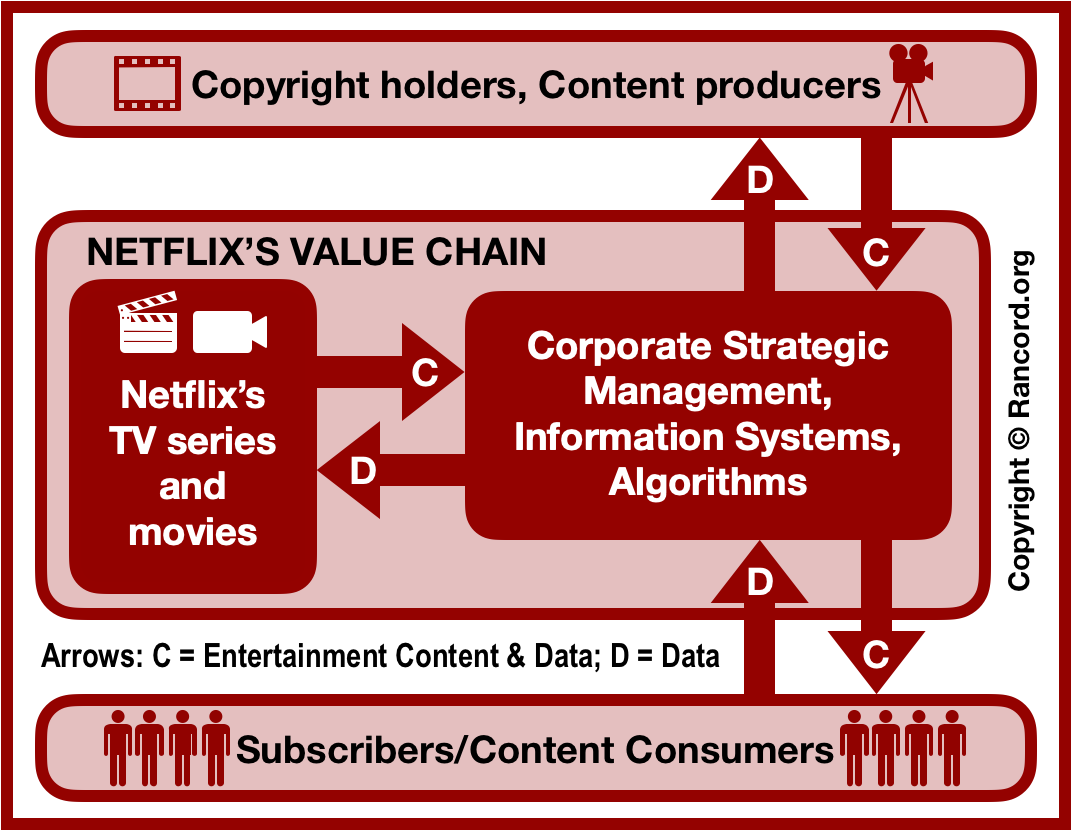
Netflix Inc.’s core competencies ensure business profitability despite increasing competition. In the VRIO/VRIN analysis framework, these competencies reflect the online company’s resources and capabilities that support long-term competitive advantage. For example, Netflix’s value chain uses these core competencies to deliver effective services to customers or subscribers. A VRIN/VRIO analysis of the company presents a resource-based view of the on-demand media streaming business, and identifies the most significant resources and capabilities for sustainable competitive advantages. As Netflix’s strategies change, so do the factors contributing to core competencies pertinent to the strategic planning process. Regular value chain analysis and VRIO/VRIN analysis of the streaming business can provide an insightful resource-based view of current operational conditions and strategic positioning. The satisfaction of Netflix’s corporate mission and vision statements depends on how the business core competencies and value chain remain strategically effective in the industry.
As an influencer in the online entertainment market, Netflix Inc.’s value chain maintains competitive power against large firms, such as YouTube (Google), Amazon, Walmart, Apple, Disney, and HBO. This level of rivalry requires companies to develop competitiveness that responds to market trends in consumer preferences for entertainment content. The core resources and capabilities identified in this VRIN/VRIO analysis of Netflix Inc. contribute business competencies against the competition. Considering Michael E. Porter’s framework, the continued technological enhancement of the online company’s value chain addresses this strategic concern. Such technological benefit is notable with regard to Netflix’s operations management, service effectiveness and efficiency, and data security.
Netflix Inc. VRIO & VRIN Analysis & Table (Resource-Based View)
| ORGANIZATIONAL RESOURCES & CAPABILITIES | V | R | I | O | N |
| Competitive Disadvantage: | |||||
| High dependence on third-party entertainment content producers | |||||
| Competitive Parity or Equality: | |||||
| Innovativeness | ✔ | ||||
| Information technology assets | ✔ | ||||
| Temporary Competitive Advantage: | |||||
| Support and licenses from entertainment content creators and copyright holders | ✔ | ✔ | |||
| Unexploited Competitive Advantages: | |||||
| High potential for online music distribution | ✔ | ✔ | ✔ | ||
| High potential for online textual content distribution | ✔ | ✔ | ✔ | ||
| VRIN/VRIO core competencies (Long-Term/Sustained Competitive Advantages): | |||||
| High equity of the Netflix brand | ✔ | ✔ | ✔ | ✔ | ✔ |
| Large platform of content producers and consumers | ✔ | ✔ | ✔ | ✔ | ✔ |
| High capacity for original content creation | ✔ | ✔ | ✔ | ✔ | ✔ |
- This VRIO/VRIN analysis table is best viewed using HTML5-compatible browsers.
Non-core Competencies and Competitive Disadvantage. The VRIN/VRIO analysis table above shows that a major competitive disadvantage of Netflix Inc. is its high dependence on entertainment content producers. Even though its value chain involves its own original movies and TV shows, the business also distributes third-party content on the platform, with the strategic objective of attracting and retaining more subscribers. With regard to the resource-based view, this factor makes Netflix vulnerable to strategic changes and competitive forces of producers. Notable are the competitive forces of Disney and other firms that have the capability to offer their content on their own streaming platforms.
The VRIO/VRIN analysis table identifies resources and capabilities that are non-core competencies in Netflix’s value chain and business operations. For example, the streaming company’s innovativeness is a non-core competency because other large businesses possess comparable capabilities. Also, Netflix Inc.’s information technology assets offer only competitive equality or parity because other firms have similar technological resources and capabilities. In relation, contracts, licenses, and support from entertainment content producers and copyright holders are a temporary competitive advantage in the VRIN/VRIO analysis framework. Even though this strategic factor brings competitive advantage to Netflix, producers and copyright holders could enter agreements with other firms in the on-demand digital media streaming industry. In the resource-based view, the competitive advantage of such contracts may not last long, as Netflix’s competitors grow their respective online platforms and value chains.
As a major competitor in the digital media streaming market, Netflix Inc. has opportunities for further growth, based on the unexploited competitive advantages identified in the VRIO/VRIN analysis table. For example, the international scale of the company’s customer base presents the opportunity to distribute music. Netflix’s value chain and network also has the potential to distribute textual content or books to the same customer base. In the resource-based view, this capability depends on the corporation’s globally accessible online platform as a resource that enables large-scale market reach. However, these competitive advantages remain unexploited, as Netflix’s strategic management initiatives and value chain activities focus on streaming movies and TV series. The company’s leaders continue focusing on growing this streaming business. Netflix Inc.’s generic strategy for competitive advantage, business model, and intensive growth strategies depend on these resources and capabilities although they are non-core competencies.
VRIO Analysis of Netflix’s Core Competencies (Sustainable Competitive Advantages). Netflix Inc.’s core competencies identified in the VRIO/VRIN analysis table satisfy the VRIO criteria (Value, Rarity, Imperfect Imitability, and Organization). For example, the online company’s brand is one of the most popular in the world. In the resource-based view, the Netflix brand is a value chain resource that supports long-term competitive advantage. In addition, the company’s global online platform is a core competency based on the VRIO framework. For example, this platform is difficult to imitate in terms of Netflix’s scale and market reach to a large subscriber base. As a core competency, the platform enables the corporation to ensure its value chain’s effectiveness in delivering the streaming service. Also in the VRIO analysis model, another of Netflix’s core competencies is the high capacity for original content creation. Most competitors may be able to produce content, but not at the scale and frequency that the company currently does, considering the multinational size and funding of the streaming business. Netflix’s organizational culture influences this VRIO core capability to create original entertainment content.
VRIN Analysis of Netflix’s Core Resources & Capabilities. As the VRIN/VRIO analysis table shows, the VRIO and VRIN frameworks are similar, except that the VRIN analysis model includes the “N” or non-substitutability criterion for assessing the online enterprise. In this internal analysis, Netflix’s VRIO core competencies are also VRIN core competencies because they satisfy such a criterion. For example, the streaming company’s high brand equity is non-substitutable, as there is no substitute that exactly matches the value of the brand. In relation, Netflix’s large platform offers long-term competitive advantage based on the VRIN analysis framework. There is no highly similar substitute to the value of having this large digital content platform, which is difficult to grow to the global scale that the corporation currently has. Furthermore, Netflix’s value chain is large and effective enough to create original TV series and movies. In the VRIN test, this capability is a core competency because it is valuable, rare, imperfectly imitable (to such a global scale, for most competitors), and non-substitutable in terms of its operational effectiveness and efficiency in reaching online subscribers. These VRIN core competencies enhance Netflix’s value chain, and ensure the satisfaction of customers.
Value Chain Analysis of Netflix: VRIN/VRIO Resources & Capabilities in the Value Chain
The sustained competitive advantages based on the identified VRIO/VRIN core competencies enable Netflix Inc.’s value chain to deliver its value proposition to target customers. This value chain involves not just the supply chain, but also the flow of information used to satisfy subscribers. As shown in the diagram below, Netflix’s value chain has inflows and outflows involving suppliers and customers.

In the simplified value chain diagram above, the arrows show the flow of data and content as Netflix adds value before the final output is delivered to subscribers. For example, the firm’s information systems and algorithms determine personalized TV series and movie recommendations based on customers’ usage data, thereby ensuring customer satisfaction. In relation, in the VRIN/VRIO analysis, Netflix’s large platform of producers and consumers is a long-term competitive advantage. In the value chain diagram, this platform involves the information systems and algorithms. Moreover, the VRIO/VRIN analysis identifies the capacity for original content creation as a major contributor to Netflix’s sustained competitive advantage. In the value chain, this core competency is a business unit that produces entertainment content based on market data gathered from customers’ usage of the online service. Furthermore, the VRIN/VRIO core competency of high brand equity strengthens Netflix’s supply chain and the value chain by attracting more producers and consumers to the platform. All of these factors satisfy the company’s value proposition, which centers on entertaining subscribers. It is notable that parts of Netflix’s organizational structure coincide with some areas of the value chain. For example, the original programming division is responsible for the company’s content production component shown in the value chain.
Key Points: VRIO/VRIN Analysis & Value Chain Analysis of Netflix Inc.
In the VRIN/VRIO analysis framework, Netflix Inc. sustainable competitive advantages pertain to the brand and operational processes that focus on customers. These core competencies fulfill the value proposition of subscribers’ entertainment, and content producers’ multinational market access. The value chain analysis shows that these VRIO/VRIN core competencies keep Netflix’s value system effective, especially in providing satisfactory online entertainment. In the company’s value chain diagram, these core competitive advantages maintain profitable relations among the business, subscribers, and content producers and copyright holders. Netflix’s supply chain management mainly involves procurement and strategic development of business relations with producers to optimize content on the platform. Thus, relating to the streaming company’s value chain, a supply chain analysis and a competitive power test would assess such relations. Also notable is that the SWOT analysis of Netflix Inc. reflects the VRIO/VRIN core competencies as business strengths that ensure competitive power.
References
- Barney, J. B. (2017). Resources, capabilities, core competencies, invisible assets, and knowledge assets: Label proliferation and theory development in the field of strategic management. The SMS Blackwell Handbook of Organizational Capabilities, 422-426.
- Dekker, H. C. (2003). Value chain analysis in interfirm relationships: A field study. Management Accounting Research, 14(1), 1-23.
- Donaldson, K. M., Ishii, K., & Sheppard, S. D. (2006). Customer value chain analysis. Research in Engineering Design, 16(4), 174-183.
- International Trade Administration of the U.S. Department of Commerce – The Media and Entertainment Industry in the United States.
- International Trade Administration of the U.S. Department of Commerce – The Software and Information Technology Services Industry in the United States.
- Knott, P. J. (2015). Does VRIO help managers evaluate a firm’s resources? Management Decision, 53(8), 1806-1822.
- Lin, C., Tsai, H. L., Wu, Y. J., & Kiang, M. (2012). A fuzzy quantitative VRIO-based framework for evaluating organizational activities. Management Decision, 50(8), 1396-1411.
- Luo, M., & Zhou, G. (2018). Feasibility Analysis of the Scheme of Internet of Things Based on Two-Level Supply Chain Dynamics. Wireless Personal Communications, 103(2), 1263-1272.
- Netflix Inc. – Investors – Long-Term View.
- Netflix Inc.’s Annual Report to the U.S. Securities and Exchange Commission (Form 10-K).
- Netflix Inc.’s Website.
- Overby, J. W., & Min, S. (2001). International supply chain management in an Internet environment: A network-oriented approach to internationalization. International Marketing Review, 18(4), 392-420.
- Schroeder, A., & Kotlarsky, J. (2015). Digital resources and their role in advanced service provision: A VRIN analysis. In Proceedings of the Spring Servitization Conference (pp. 67-74). Aston University.
- Talaja, A. (2012). Testing VRIN framework: resource value and rareness as sources of competitive advantage and above average performance. Management-Journal of Contemporary Management Issues, 17(2), 51-64.
